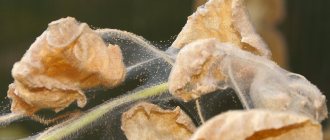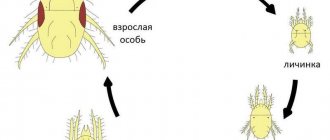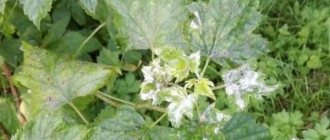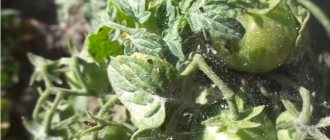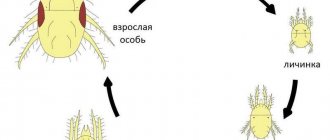What it looks like: description and photos of affected tomatoes
Adults reach approximately 1 millimeter in length, have an oval body, the color of which depends on the season. Females are much larger than males. Adult ticks are greenish-gray, dark green or yellow.
The animal's legs end in a complex claw mechanism , with which they cling to leaves. The mouthparts are adapted for piercing the skin and sucking the juice of plants.
The photo shows what spider mites look like on tomatoes.
Advantages and disadvantages of using chemicals
Advantages:
- Diverse selection of chemicals on the market;
- Wide spectrum of action (most acaricides affect not only spider mites, but also other pests;
- Chemicals affect not only adults and larvae, but also tick eggs;
- Many drugs are not addictive to insects and do not accumulate in soil and fruits.
Flaws:
- High-quality chemicals are quite expensive;
- Some drugs have a high degree of toxicity. They can be harmful to human health;
- There are many counterfeits of original products on the market.
Why is it dangerous?
At an air temperature of approximately +12 - +14 degrees, females come out of the shelter, settle on the lower part of plant leaves, entangle them in a web, laying eggs. This leads to a change in the color of the leaves and their falling off. Ticks reproduce especially actively in dry, hot weather, at temperatures above +26 degrees. They are able to instantly move from one plant to another.
The salivary glands of these animals secrete complex organic substances that destroy the chloroplasts of plant cells. Mites prefer to be closer to the root zone, where they suck out the sap, interfering with the normal growth and development of the plant. The pest can also infect the plant with dangerous viral infections and gray rot spores.
Reasons for appearance
Pests prefer to settle in dried fallen leaves , then move onto the plant.
Dust on leaves is also a suitable environment for mites. During the winter, the parasite hides under foliage or stones. It is comfortable for the pest to reproduce in a greenhouse, since there are the most comfortable conditions for its existence. Spider mites do not tolerate moisture and reproduce well in a warm place, in open ground or in a greenhouse. Favorable conditions for the appearance of ticks: air temperature + 25- +28 degrees, with air humidity less than 60%.
Signs of spider mite damage to tomatoes
As a rule, the female spider mite emerges from diapause in mid-spring, towards the beginning of May. At this time, the insect prefers to settle on weeds, where it lays its eggs. Within a month (late May - early June), the tick moves to crop plantings and begins to actively parasitize them. At this time, it is very important to conduct a thorough inspection of the plants in order to detect signs of spider mite damage to tomatoes in time. Most often, the first pests choose the underside of young leaves, closer to the top of the tomato.
Finding small whitish or yellowish spots (Photo) or discolored areas indicates the presence of a parasite on your tomatoes. The spots formed at the site where the leaves were punctured, where the mite began to actively suck the vital juices from the plant. If you do not take immediate action, the leaves will soon begin to curl, dry out and fall off. After some time, it will be possible to see with the naked eye accumulations of cobwebs, indicating the presence of a large colony of insects.
It is along the web that the mite moves between parts of the plant or migrates to other tomato bushes. However, it would be extremely reckless on your part to wait for the web to appear - the fight against ticks must begin much earlier - long before the appearance of the parasite.
Differences from other pests
Signs:
- white small dots on the back of the leaves;
- the leaves of the plant dry out;
- the presence of a delicate white cobweb on seedlings;
- very few flowers on the plant;
- frequent watering does not produce results;
- the reproduction process begins earlier than in other pests.
How to fight?
Options for combating this parasite depend on its quantity and the degree of damage to the tomato. Basically, several methods of struggle are used in practice. In case of severe damage to tomatoes, chemical preparations should be used; in case of minor plant infection, folk remedies will help.
In a greenhouse, the pest reproduces all year round. In this case, biological control measures are used. The predatory mite (Phytoseiulus), according to experts, is capable of destroying this pest. We also must not forget about preventive control measures.
How can plants be treated?
If the pest population on tomatoes is large, chemical treatment is recommended. The preparations can be used no later than 15–25 days before harvest.
Application of acaricides
The prepared solutions are sprayed on the plants and the soil near the plantings is disinfected.
Chemicals against this pest that experts recommend:
- "Iskra-BIO";
- "Aktellik";
- "Kleschevit."
It is advisable to spray plants 2-3 times during the growing season.
- " Aktellik ". You can buy Actellik in ampoules of 2 ml. The contents of the Actellik ampoule (2 ml) are dissolved in two liters of water. The price of Actellik in ampoules of 2 ml is 30 rubles.
- " Iskra-BIO ". Iskra Bio is sold in the form of an emulsion in ampoules of 1 ml. The drug "Iskra Bio" 10 ml can be bought for 86 rubles. Spraying is carried out twice during the growing season with an interval of 17-22 days.
- " Kleschevit ." A very affordable product: a 4 ml ampoule costs 20 rubles. Dilute 4 ml of the substance in 1 liter of water.
Special medications at home
In the fight against spider mites at home, you can treat plants with gentle means; if they do not help, only then use broad-spectrum acaricides. Gentle means include:
- Bitoxibacillin;
- Phytofarm.
Bitoxibacillin .
Dilute 40-100 grams of powder per 10 liters of water (water temperature 15-25 degrees). Dilute the product in a small container, then add the required amount of water, mix, spray with a sprayer twice: at the beginning of June and at the end of July. Tomatoes should not be eaten for a week after spraying. Cost of the drug: 20 grams - 20 rubles.
Fitoferm .
For 10 liters of water – 100 ml of substance. To prepare the solution, you should pour 1-2 liters of water into a bucket, measure out the required amount of the drug and pour it into the bucket. Stir well, then add the required amount of water and stir again. Spray twice during the growing season. Price: 68 rubles for 10 ml of the drug.
Biological methods
The biological method involves the use of mites that destroy spider mites, as well as the use of biological products. List of effective biological products:
- Akarin;
- Agravertine;
- Bitoxibacillin;
- Fitoverm.
- During treatment with Aktara, phytophagous mites die.
- Fitoverm is characterized by low toxicity for both people and animals.
- Agravertine can be used for a long time, as it is not addictive and does not allow pests to adapt to the effects of its components.
- On the 2nd – 3rd day after treating plants with Akarin, the pests die. The fifth or sixth day is the day of maximum effectiveness of the drug.
Traditional methods
- Infusion of henbane. Spray with the solution at intervals of 6 to 8 days. The infusion is prepared as follows: 1 kg of herb is poured into 10 liters of water and left for 12 hours. Before spraying, add laundry soap.
- Soap solution. A mixture of laundry soap and water is prepared in a ratio of 6:1. The leaves are wiped with the prepared product. In case of massive damage, tomatoes are sprayed with a spray bottle. For spraying, the solution is prepared in a ratio of 4:1.
- Dandelion tincture. For 10 liters of water take 400 g of raw materials. Leave for two hours and spray the tomatoes. Repeat spraying every two weeks.
- Infusion of garlic or onion. These infusions help get rid of ticks in greenhouse conditions. You need to take 400 g of garlic or 200 g of onion peel and pour 4 liters of water, leave for 5 hours, and then spray the tomatoes.
- You can also use infusions of wormwood, potato stems or leaves, walnut leaves, and horseradish.
Chemicals
Acaricides or insectoacaricides should be used against an almost invisible enemy. During the period when the plant begins to bear fruit, you should not treat it with chemicals. Disinfection with strong poisons should be carried out at least 2-3 weeks before collection.
For chemical treatment, you can choose one of the following drugs:
- Neoron;
- Anti-mite;
- Aktellik;
- Fufanon;
- Sunmite;
- Aktofit;
- Spark – BIO;
- Flumite;
- Borneo.
The method of application is identical for everyone. First, a solution is prepared, which is then used to spray the tomatoes themselves. It is imperative to disinfect the soil near the planting. The walls of greenhouses and greenhouses should be treated at the same time; experienced gardeners prepare for the season and spray them in advance.
It is better to apply a loading dose of drugs immediately in order to prevent further proliferation of pests.
Worth remembering! Spider mites develop immunity to certain chemicals.
Prevention
Preventive measures include the following:
- Check your plants systematically for any signs of infestation.
- Before purchasing seedlings, carefully check them for mites.
- Plant tomatoes at some distance from each other (about 30 cm).
- Spray plants both inside and outside the greenhouse.
- If tomatoes are grown in a greenhouse, maintain high humidity.
- Ventilate your greenhouse regularly.
- If the greenhouse has windows, install insect screens.
- Destroy all infected plants.
- Collect and destroy pests immediately.
Gardening tips
There are four main rules, the implementation of which allows you to annually collect a large number of aromatic tomatoes from the beds:
- variety selection;
- timely control of parasites;
- planting healthy seedlings;
- selection of the appropriate site;
- prevention and maintenance of appropriate care.
All of the above actions help increase crop yields.
Important. Covered tomatoes are more susceptible to spider mite attacks. Is it possible to get a high-quality, decent harvest of tomatoes? Of course, if you listen to the advice of experienced gardeners.
Where does it winter
The change in color of females at the end of summer or at the beginning of autumn is associated with the cessation of feeding and preparation for wintering. Only fertilized females survive until spring.
Such females are resistant to cold temperatures down to -28°C and in some regions overwinter in the upper layers of the soil. The maximum survival rate is among “greenhouse” mites.
Remains of tops and weeds on the site, cracks in the bark of trees, and a layer of fallen leaves also become a haven for spider mites.
Without autumn treatment of shelters and soil, and cleaning the area, it is impossible to remove the pest.
In spring, the spider mite wakes up when the temperature rises to +12°C and begins laying eggs.
The first generation of arthropods is represented by individuals of both sexes.
